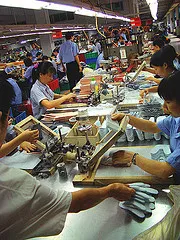
China’s manufacturing PMI stable at 49.95 in September
This is a bit better than August’s 49.91, as the slowdown in China's manufacturing sector is showing signs of stabilizing.
HSBC retains its forecast of 8.5-9% GDP growth for the coming quarters.
Here’s more from HSBC:
| Slowdown stabilising September's final PMI came in at 49.95, higher than last week's flash reading and slightly better than August's final number, suggesting that the slowdown in China's manufacturing sector is stabilising. Slowing global demand will start to weigh on growth soon, but resilient domestic consumption and investment should prevent a sharp output slowdown. We retain our forecast of 8.5-9% GDP growth for the coming quarters. Facts The employment sub-index also fell into contraction territory again (49.9 vs. 50.3 in August), but only marginally. Inventory of finished goods continued to contract as well, dropping to a three-month low of 46.8 in September, thanks to relatively subdued output growth. Growth momentum, as measured by the difference between new orders and finished goods inventory, rebounded to 3 in September from 2 in August (compared to the average of 2.3 in 3Q and 3.8 in 2Q). Both the input and output price sub-indices rebounded in September closer to the levels seen in 2Q. Input prices rose to a four month high of 59.5 in September (vs. 55.9 in August), due to high raw material prices. Output prices surged to a five month high of 54.3 in September (vs. 52.3 in August). Note that both input prices and output prices are now only a touch lower than the series' long term average. Implications: The third consecutive month of a below-50 PMI print implies that China's manufacturing sector will continue to weaken on a sequential basis in the coming months. However, the relative improvement in the "new orders and finished goods inventory" reading suggests that this slow-down is starting to stabilize. As such, despite the lagged effects of credit tightening and a lackluster external outlook, activity in China's manufacturing sector is expected to hold steady . External demand has weakened a little but with the latest official exports growth number still rising at over 20% y-o-y, the impact is not yet significant. Although we expect exports growth to moderate further in the coming months due to weakening external demand, provided the US and European economies do not both enter a simultaneous recession, we do not expect a severe dip on the scale of the 2008/09 downturn. Even if exports growth fell, the impact should be much smaller than before as China is less dependent on net exports in the post-crisis era. Net exports' contribution to GDP stood at only -0.7% in 1H this year. On the domestic front, resilient domestic demand remains sufficient to support a growth rate of around 8.5-9% growth in the coming quarters. The rebound of China's PMI prices sub-indices, combined with a recent pick-up in inflationary expectation, underscores how inflationary pressures remain high. Despite that, we still believe headline inflation has peaked in July, and that China's headline inflation print will recede very gradually in the coming months. Bottom line: China's growth moderation is starting to show some signs of stabilization. Although the lagged effects of credit tightening will continue to cool industrial activity in the months ahead, there remains little need to worry about a growth meltdown. Despite weakening external demand, we expect China's economic growth to hold up at around 8.5-9% in the coming quarters, underpinned by still resilient domestic demand. |








![Cross Domain [Manu + SBR + ABF + ABR + FMCG + HBR + ]](https://cmg-qa.s3.ap-southeast-1.amazonaws.com/s3fs-public/styles/exclusive_featured_article/public/2025-01/earth-3537401_1920_4.jpg.webp?itok=WaRpTJwE)









 Advertise
Advertise


